Top 10 AI Marketing Apps & Benefits – Power of Artificial Intelligence
2 years agoFrom Dashain to Holi: Top 20 Festivals in Nepal You Must Experience (Nepali Wishes)
2 years ago -
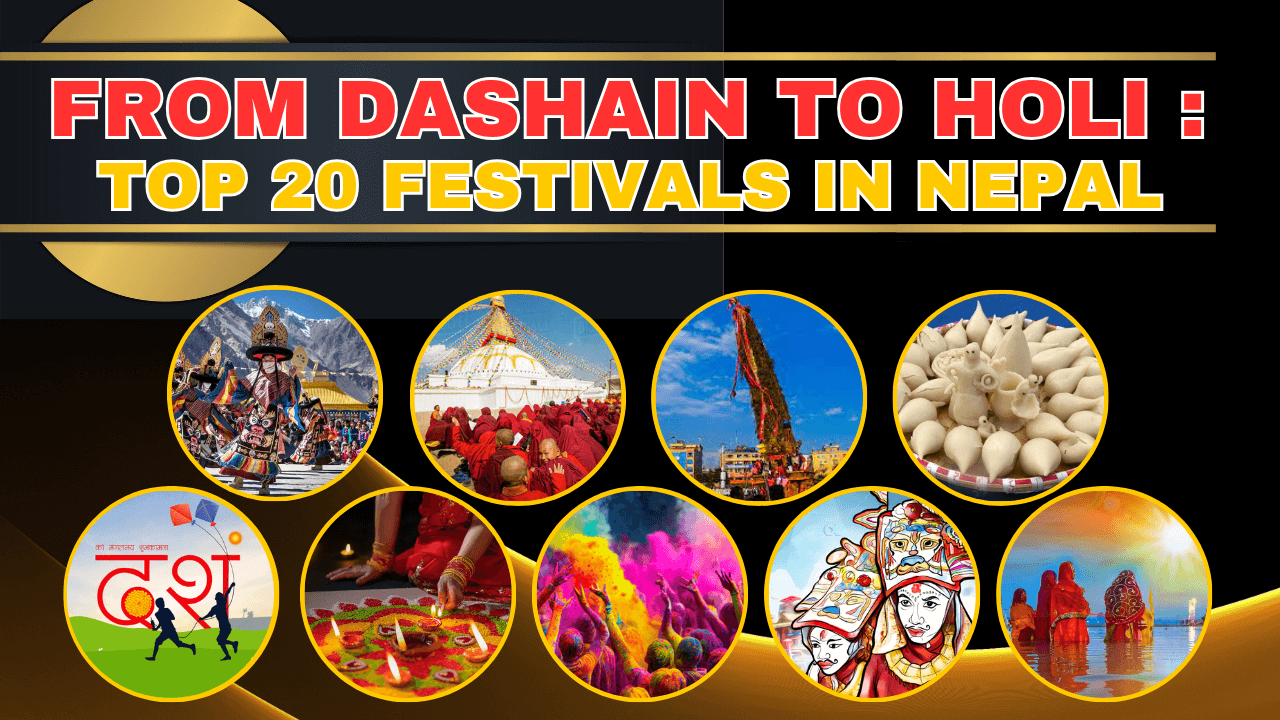
If you’re curious about the lively and culturally rich country of Nepal, you’ll be delighted to discover that the festivities here are as diverse as the landscape itself. In Nepal, every day feels like a celebration. With this article, we will take you on a captivating journey through the top 20 festivals in Nepal celebrated in this beautiful Himalayan nation.
From the serenity of Buddha Jayanti to the raucous joy of Holi, the festivals of Nepal reflect the nation’s deep-rooted beliefs and values. The rituals, dances, music, and food are all interconnected, forming a tapestry of traditions that resonate with both locals and travelers.
So, if you’re planning a visit to Nepal, consider timing it with one of these festivals to fully immerse yourself in the rich and colorful culture of this Himalayan kingdom. Whether you’re witnessing the pulling of the Rato Machindranath chariot, trying a delicious Yomari dumpling during Yomari Punhi, or experiencing the electrifying horse races at Ghode Jatra, these festivals offer unique and authentic experiences that you won’t find anywhere else in the world.
Table of Contents
Now, let’s delve into each of these top 20 festivals in Nepal, exploring the colors, traditions, and significance they bring to the Nepalese people.
1. Dashain (दशैं): The National Festival
Dashain (दशैं), often referred to as Vijaya Dashami, is Nepal’s biggest and longest festival. It is a Hindu festival celebrated by people of all faiths. The festival symbolizes the victory of good over evil and is marked by the worship of the goddess Durga.
Dashain, one of the top 20 festivals in Nepal, lasts for nine days, known as “Navaratri,” and holds special significance. Each day of Dashain has a unique religious and cultural significance, and it involves various rituals and observances:
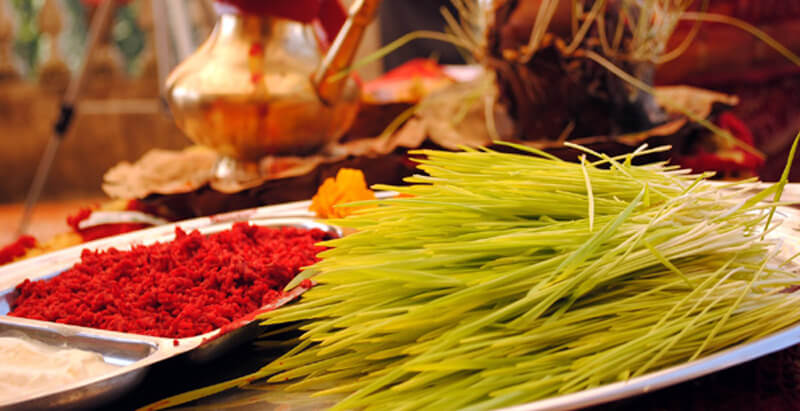
- Ghatasthapana (Day 1): The first day of Dashain marks the beginning of the festival. On this day, a sacred vessel called “kalash” is set up in the family shrine, and seeds, usually maize, barley, and wheat, are sown.
- Sleshmantak (Day 2): On the second day, barley seeds grown from the kalash are collected and used for religious purposes. In some communities, it is also considered the day to cleanse and purify the seeds for planting.
- Phulpati (Day 7): The seventh day of Dashain, known as Phulpati, involves the gathering of various flowers, leaves, and plants from the wild. These offerings are used in the worship of Goddess Durga and other deities.
- Maha Asthami (Day 8): The eighth day, Maha Asthami, is dedicated to the goddess Kumari. It is a day of animal sacrifices, and in some regions, buffaloes, goats, or other animals are sacrificed in temples as an offering to the goddess.
- Maha Nawami (Day 9): The ninth day, Maha Nawami, is the most important day of Dashain. It is dedicated to Goddess Durga. People worship the goddess and receive “tika” (a mixture of yogurt, rice, and vermillion) and “jamara” (barley sprout) from their elders as a blessing.
- Vijaya Dashami (Day 10): The tenth day is Vijaya Dashami, the most crucial day of Dashain. It symbolizes the victory of good over evil. Families perform a ritual known as “tika and jamara,” where elders give blessings to the younger members, and it is also the day when elders give “dakshina” (money) to the younger family members.
- Ekadashi (Day 11): This day is dedicated to visiting and worshiping the homes of the maternal side of the family. It’s a day for family gatherings and bonding.
- Dwadashi (Day 12): On the twelfth day, people continue to visit relatives and receive blessings from family members.
- Kojagrat Purnima (Day 15): Dashain officially concludes on the fifteenth day. This day is known as Kojagrat Purnima. People stay awake throughout the night, playing cards, enjoying festive meals, and seeking blessings for good fortune.
These nine days of Dashain are a time of family gatherings, cultural celebrations, and religious observances that strengthen the bonds between family members and communities.
Here are 10 Dashain quotes in Nepali languages:
- “बडा दशैंको शुभकामना! खुशी र शान्तिको यस महापर्वमा पूरा होस्।”
- “आफ्नो सम्पूर्ण खुशिहरूलाई परिवार र साथीहरूसँग साझा गर्दै दशैं मनाउनुहोस्।”
- “परिवारमा बढ्ने नेपालको आधिकारी दशैंको पर्वमा मिल्दछ।”
- “जयंती मङ्गला काली भद्रकाली
कपालिनी दुर्गा शिव धात्री स्वाहा शोध्न नमोस्तुते।
नेपालीहरूको महान पर्व बडा दशैं २०८० को मङ्गलमय शुभकमाना
तपाईंहरूलाई सदा खुश रहनु होस्, सुखी रहनु होस्।” - “सपना पुरा हुनको आशिर्वाद दशैंको पर्वमा पाइएको छ।”
- बडा दशैं, शुभ दिपावाली तथा छठ पर्व २०८० को पावन अवसरमा यहॉको सुख, शान्ति, समृद्धी एवं सुस्वस्थ्यको हार्दिक मंगलमय शुभकमाना व्यक्त गर्दछौं ।
- “२०८० सालको पावन-अवसरमा सुख-संवृद्धि तथा दिर्घायुको कामना गर्दै बिजया-दशमीकाे हार्दिक मंगलमय शुभकामना ब्यक्त गर्दछु!!! दुर्गा भवानीले हामी सबैको कल्याण गरुन!!”
- “दशैं आएको छ, जसले सपनाहरूलाई साकार गर्दैछ र आफ्नो भन्दा पनि मनपर्दैन।”
- “परिवारको आसिर्वादमा समृद्ध भएको दशैंको शुभकामना!”
- “पुरा हाेस् तपाइकाे मनाेकामना,
यहि छ विजया दशमिकाे हार्दिक मंगलमय शुभकामना !!!”
2. Tihar (तिहार) : The Festival of Lights
Tihar, the “Festival of Lights,” is a top 20 festivals in Nepal, a beautiful and enchanting celebration of various animals and birds. In Tihar, you’ll witness the worship of dogs, cows, and even crows. The festival lasts for five days and illuminates the streets with oil lamps and colorful rangoli.
Here are the five days of the Tihar festival:
- Day 1: Kaag Tihar (Crow Puja): The first day is dedicated to crows. Crows are considered to be messengers, and it’s believed that by offering them food, you’ll be informed about your guests. People offer sweets and grains to the crows early in the morning.
- Day 2: Kukur Tihar (Dog Puja): On the second day, dogs, regarded as loyal friends and guards, are honored. They are adorned with flower garlands and tikas (vermillion) on their foreheads. Special meals and treats are prepared for them as a sign of gratitude.
- Day 3: Gai Tihar and Laxmi Puja (Cow and Goddess Laxmi Puja): The morning is dedicated to worshiping cows, which are considered sacred and a source of wealth. In the evening, Goddess Laxmi, the deity of wealth and prosperity, is celebrated. Homes are illuminated with oil lamps, candles, and colorful rangoli to welcome her. People also worship their financial assets and seek her blessings.
- Day 4: Goru Tihar and Govardhan Puja (Oxen and Mountain Worship): The fourth day is dedicated to oxen. They are bathed and decorated, and their horns are painted. In the evening, Govardhan Puja is observed. People make a symbolic mountain out of cow dung to represent Lord Krishna lifting Mount Govardhan to protect the villagers from torrential rain.
- Day 5: Bhai Tika: The fifth and final day of Tihar is known as Bhai Tika. It’s a day to celebrate the bond between brothers and sisters. Sisters perform a special ritual where they apply tika and garlands to their brothers, wishing them a long and prosperous life. In return, brothers give gifts and money to their sisters.
Tihar is one of the top 20 festivals in Nepal, which is a celebration of the bond between humans and animals, as well as between family members. The lighting of lamps, colorful decorations, and expressions of love and gratitude make it one of the most beloved festivals in Nepal.
Here are 10 Tihar quotes in Nepali languages:
- लक्ष्मी र गणेश को कृपाले काममा सफलता मिलोस्, सुख शान्ती र समृद्धि प्राप्त होस्।
- तिहारको शुभकामना सबैमा
यो तिहार ले
ज़िन्दगीमा भोगेका (ती-हार) हरुलाई
जितमा परिवर्तन गरोस - सम्पूर्ण नेपालीको घरमा सुख शान्ति र समृद्धि छाओस
तिहारको मंगलमय शुभकामना - तिहारको यस पावन अवसरमा तपाईंको जीवनमा सुख, शान्ति, र समृद्धि कायम रहोस्।”
- “तिहारको यो पर्वले तपाईंको घर धेरै सुन्दरी र खुशिहरूले भरेको होस्।
- हिन्दुहरुको महान पर्व २०८० सालको
तिहारको सम्पुर्ण नेपाली दाजु भाइ
दिदी बहिनीहरुमा सुख, शान्ती
समृद्धि तथा उत्तरोत्तर प्रगतिको लागि
हार्दिक मंगलमय शुभकामना ब्यक्त गर्दछु - तिहारको शुभकामना
देश बिदेशमा रहनु भएको समस्त नेपालिजनहरुमा तिहारको शुभकामना - २०८० सालको तिहारको पावन अवसरमा
तपाई र तपाईको पुरा परिवारलाई हार्दिक मंगलमय शुभकामना - “तपाईंको सपना पुरा होस् र जीवन उज्यालो र सुखमय बनोस्।”
- “तिहारको यस पावन अवसरमा तपाईंको सबै इच्छा पुरा होस् र तपाईंको नयाँ आशा र सम्पत्तिको सपना पुरा होस्।”
3. Holi: The Colorful Celebration
Holi in Nepal is a joyful explosion of colors, just like in India. It’s a top 20 festivals in Nepal that signifies the triumph of good over evil. People smear each other with colored powders and water balloons, creating a vibrant atmosphere of love and unity. Holi typically falls in March, marking the arrival of spring, and it is a time of great merriment and community bonding.
Holi has its roots in Hindu mythology and is celebrated to commemorate various legends. One of the most popular stories behind Holi is the legend of Prahlad and Holika. Prahlad, a young devotee of Lord Vishnu, is said to have survived a fire set by his evil aunt Holika, who was immune to fire. This tale symbolizes the victory of good over evil and the triumph of devotion and righteousness.
On the day of Holi, the atmosphere is filled with laughter, music, dance, and, most importantly, colors. People of all ages come together, armed with colored powders, water balloons, and water guns. They playfully drench each other in vivid and vibrant hues, shouting “Holi Hai!” which means “It’s Holi!” Dancing to the rhythm of traditional and modern music, people let go of inhibitions and relish the spirit of togetherness.
Here are 10 Holi wishes to share with your loved ones:
- “May your life be as colorful and vibrant as the festival of Holi. Happy Holi!”
- “Wishing you a Holi filled with sweet moments and colorful memories. Have a joyful celebration!”
- “May the colors of Holi fill your heart with love and happiness. Happy Holi to you and your family.”
- “Let’s make this Holi a time to forgive, forget, and mend broken relationships. Happy Holi!”
- “May the festival of Holi bring you good health, wealth, and prosperity. Have a wonderful celebration!”
- “On this Holi, may you find the courage to chase your dreams with enthusiasm and passion. Happy Holi!”
- “Wishing you a Holi filled with laughter, fun, and the company of good friends. Enjoy the festival to the fullest!”
- “May your life be as colorful as the rainbow, and may your days be filled with love and laughter. Happy Holi!”
- “May the festival of colors fill your life with joy, peace, and harmony. Happy Holi to you and your loved ones!”
- “Let the colors of Holi spread the message of love, happiness, and unity. Have a fantastic and safe Holi!”
4. Buddha Jayanti: Commemorating the Sage
Buddha Jayanti is a significant top 20 festivals in Nepal for Buddhists. It celebrates the birth, enlightenment, and death of Lord Buddha. Lumbini, the birthplace of Buddha, is the center of festivities during this time. Buddha Jayanti is observed on the full moon day in the Vaisakha month of the Hindu lunar calendar, which usually falls in April or May. It is a time to reflect on the life and teachings of Lord Buddha, whose wisdom and principles have had a profound impact on the spiritual and philosophical landscape of the world.
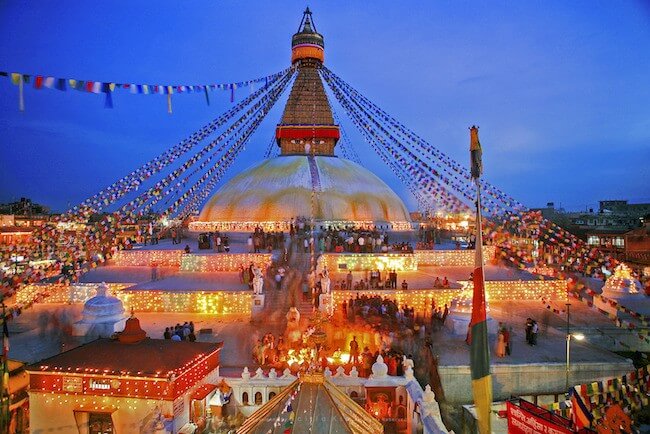
The Universal Message of Buddha Jayanti:
Buddha Jayanti is not only a religious top 20 festivals in Nepal but a reminder of the profound and universal teachings of Siddhartha Gautama. His teachings emphasize the Four Noble Truths and the Eightfold Path, which lead to the cessation of suffering and the attainment of enlightenment. These principles transcend religious boundaries and continue to inspire people around the world to seek inner peace, self-awareness, and a life of compassion and wisdom.
As the world celebrates Buddha Jayanti, it’s an opportunity for people of all backgrounds to reflect on the timeless wisdom of Buddha and consider how his teachings can be applied to lead a more meaningful and harmonious life. It is a day when the profound legacy of the sage is celebrated, serving as a reminder that the path to enlightenment is open to all who seek it, regardless of their faith or background.
Here are 10 quotes and wishes to celebrate Buddha Jayanti:
- “On this auspicious day of Buddha Jayanti, may you find inner peace, enlightenment, and the path to a life filled with compassion and wisdom.”
- “Let us remember and honor the sage who showed us the way to a life of peace and harmony. Happy Buddha Jayanti!”
- “May the teachings of Lord Buddha guide you to a life of mindfulness, love, and contentment. Happy Buddha Jayanti!”
- “Wishing you a serene and joyful Buddha Jayanti. May the light of wisdom always shine upon you.”
- “Just as a flower does not pick and choose the bees that come to it, may you radiate love and kindness to all beings. Happy Buddha Jayanti!”
- “On Buddha Jayanti, let’s embrace the wisdom of the enlightened one and strive to make the world a more compassionate place.”
- “May the lotus of your heart bloom with the virtues of peace and enlightenment. Happy Buddha Jayanti!”
- “The greatest gift you can offer on Buddha Jayanti is the gift of kindness and understanding. Spread it far and wide.”
- “As we celebrate Buddha Jayanti, may you find solace in the serenity of your soul and the enlightenment of your mind.”
- “On this Buddha Jayanti, may you walk the noble path with strength, courage, and unwavering faith in the teachings of Lord Buddha.”
Happy Guru Purnima Best wishes
5. Indra Jatra: Worshiping the Rain God
Indra Jatra is a Newar top 20 festivals in Nepal dedicated to Lord Indra, the god of rain. It includes various processions and the Kumari Jatra, where the living goddess Kumari is paraded through the streets of Kathmandu. The festival is held in honor of Lord Indra, who is revered as the god of rain in Hinduism. Nepal, being primarily an agrarian society, heavily depends on the monsoon rains for its agricultural success. As such, the festival is a way to express gratitude for the much-needed rain that sustains life in the region.
Moreover, Indra Jatra is also celebrated to commemorate the victory of King Laxmi Narsingh Malla over the demon deity Machhindranath. The festival holds a special place in Newar culture and is significant for its historical and social importance.
The Celebrations:
- Kumari Jatra: The festivities begin with the Kumari Jatra, where the living goddess Kumari, a young prepubescent girl revered as a deity, is paraded through the streets of Kathmandu in a chariot. The Kumari acknowledges the greetings of the public from her chariot.
- Raising of the Yosin Pole: The most iconic event of Indra Jatra is the raising of the Yosin Pole, a tall ceremonial pole that symbolizes Lord Indra’s presence during the festival. This pole is erected at Basantapur Durbar Square, and it’s a challenging and awe-inspiring event that requires skill and coordination.
- Kasaa: Young boys, traditionally dressed as gods and goddesses, participate in a masked dance called “Kasaa.” This ritual dance is believed to drive away evil spirits and purify the surroundings.
- Offerings and Prayers: People offer various food items, fruits, and other symbolic offerings to Lord Indra at the Kathmandu Durbar Square’s Akash Bhairab temple. This is done to invoke his blessings for rain and a good harvest.
- Lakhe Dance: The Lakhe dance, performed by dancers dressed as demon deities, is another intriguing feature of the festival. This dance is believed to protect the city from evil influences.
6. Gai Jatra (गाई जात्रा) : The Festival of Cows
Gai Jatra, or the “Festival of Cows,” is celebrated with humor and satire. It’s a way for the Nepalese to remember their loved ones who have passed away during the year. Families with recently deceased members participate in a procession.
The festival is particularly significant for the Newar community, an indigenous ethnic group of the Kathmandu Valley, but it is celebrated with enthusiasm and participation from people of all backgrounds.

The Celebrations:
- Cows as Holy Animals: Cows are considered sacred in Hinduism, and it is believed that they help guide the souls of the deceased to the afterlife. Therefore, during Gai Jatra, families who have lost a loved one in the past year lead a decorated cow or a child dressed as a cow in a procession through the city streets.
- Majipa Lakhey Dance: One of the most iconic elements of Gai Jatra is the Majipa Lakhey dance. Dancers dressed as Lakhey, a demon deity in Newar culture, perform a traditional dance that symbolizes the triumph of good over evil.
- Satirical Skits: The festival also incorporates elements of humor and satire. People participate in satirical skits, often making fun of political leaders and societal issues. These performances are a way of coping with grief and providing comic relief.
- Traditional Attire: Participants often wear traditional Newar attire, and many families create colorful and intricate costumes for the cow that leads their procession.
- Paying Respects to the Deceased: During Gai Jatra, families visit the cremation ghats and temples, making offerings to honor the memories of their departed loved ones.
- Community Participation: The festival encourages a strong sense of community and togetherness. People from all walks of life come together to share in the festivities, offer their condolences, and express their solidarity with those who have experienced loss.
Some Quotes:
- “Gai Jatra’s jesters and performers teach us that sometimes, laughter is the best tribute to our departed loved ones.”
- “Gai Jatra: A celebration of life’s journey, where we honor the past and embrace the future with laughter.”
- “In the heart of Nepal, Gai Jatra’s joyous procession reminds us that life’s losses can become a canvas for artistic expression.”
- “Gai Jatra गाई जात्रा teaches us that even in the face of loss, we can find the strength to celebrate life’s vibrant colors.”
7. Maghe Sankranti ( माघे सङ्क्रान्ति) : Welcoming Longer Days
Maghe Sankranti marks the winter solstice and the arrival of longer days. Also known as Makar Sankranti, is a significant Hindu festival celebrated in Nepal, India, and other South Asian countries. People eat traditional foods like sesame seeds, molasses, and yam, symbolizing the transition from winter to spring.
This auspicious day marks the transition of the sun into the zodiac sign of Capricorn (Makara), heralding the arrival of longer days and the end of the winter solstice. Maghe Sankranti typically falls on January 14th, and it’s a time for joy, devotion, and celebration.
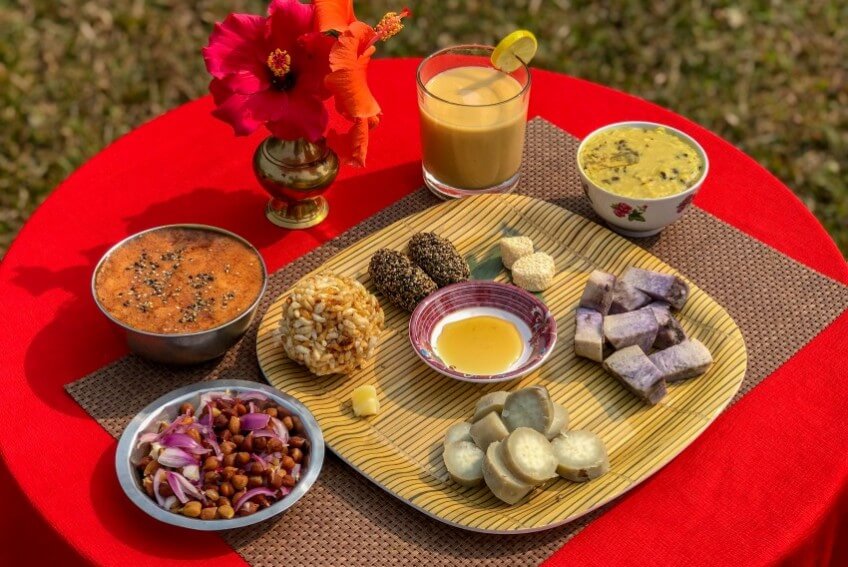
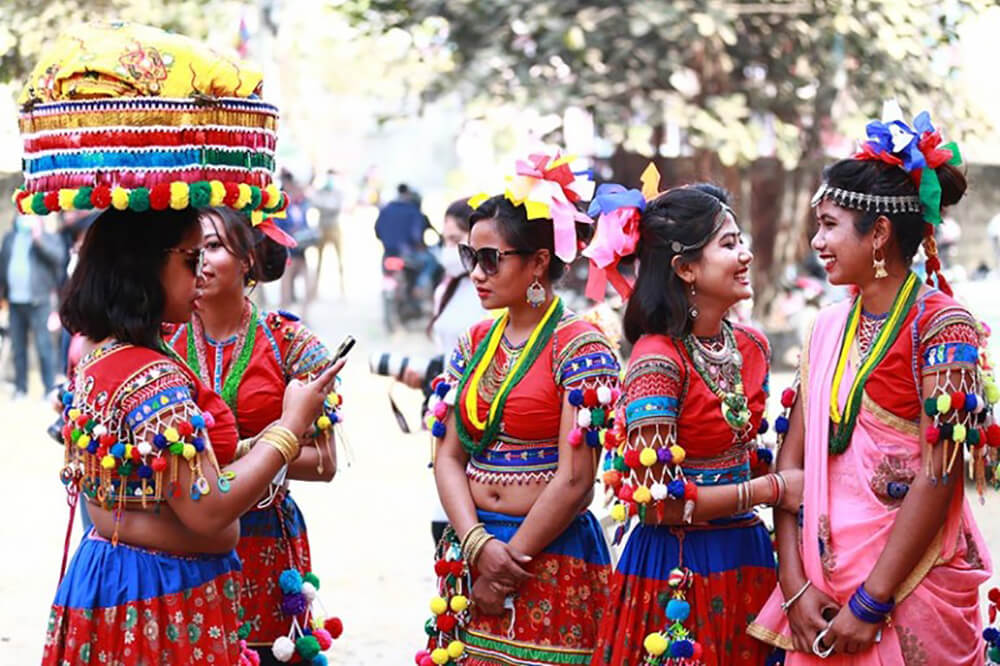
Maghe Sankranti holds deep spiritual and cultural importance. It’s a celebration of the sun god, Surya, and an expression of gratitude for the end of the cold, dark winter days. The festival signifies the beginning of the harvest season, as farmers prepare to reap the benefits of their hard work.
8. Mani Rimdu: A Buddhist Spectacle
Mani Rimdu is a Sherpa festival celebrated in the Solu-Khumbu region. It involves colorful masked dances, prayers, and rituals, primarily performed by the monks.
Mani Rimdu is a Sherpa festival with strong ties to Tibetan Buddhism. It is celebrated in the honor of Guru Rinpoche, or Padmasambhava, who is credited with introducing Buddhism to Tibet and the Himalayan regions. The festival is celebrated with the belief that it will bring peace, happiness, and prosperity to the community.

Mani Rimdu is not only a religious festival but also a spectacular display of Himalayan culture and art. Its vibrant and visually captivating mask dances draw visitors and tourists from around the world. It offers a unique insight into the rich spiritual traditions of the region and showcases the harmonious blend of culture, devotion, and community.
9. Losar (लोसार): Tibetan New Year in Nepal
Losar, the Tibetan New Year, is celebrated with much enthusiasm in the Tibetan community of Nepal. The festival features vibrant dances, music, and the preparation of special foods.
Losar is a time for new beginnings, renewal, and the welcoming of a fresh year. The word “Losar” translates to “new year” in Tibetan. It carries deep spiritual significance and cultural traditions rooted in Tibetan Buddhism.
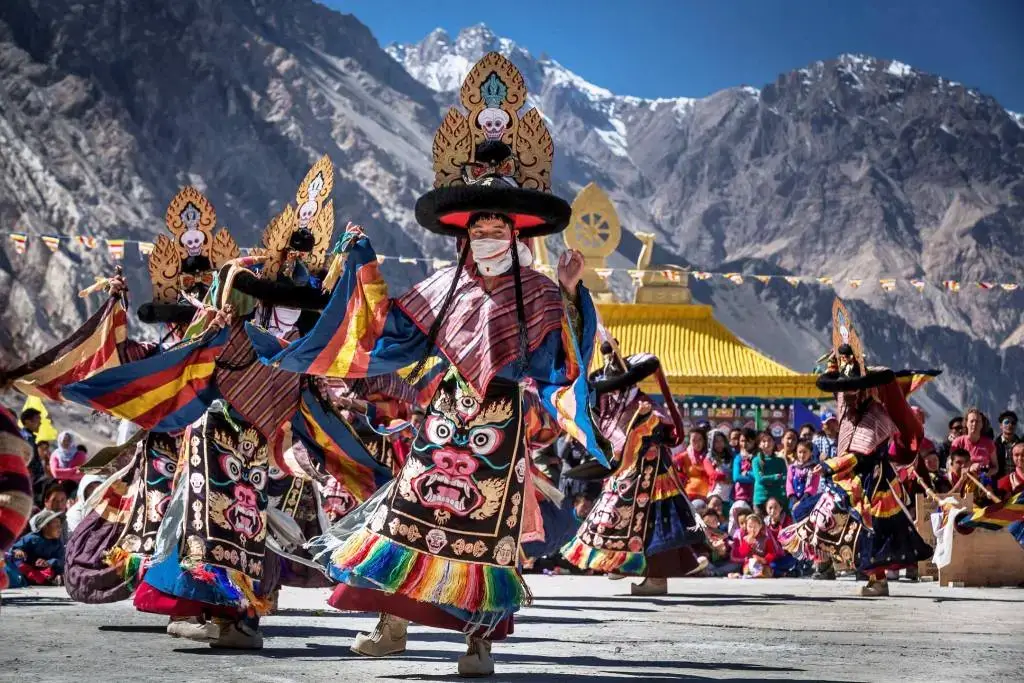
The celebration:
- Prayer and Meditation: Losar begins with visits to monasteries and temples for prayer and meditation. The first day is dedicated to offering prayers for peace, prosperity, and the well-being of all sentient beings.
- Monastic Rituals: Monks in monasteries perform intricate rituals and ceremonies to invoke blessings and ward off negative energies. The sound of ceremonial horns, drums, and chants fills the air.
- Butter Sculptures: An integral part of Losar is the creation of intricate butter sculptures. Monks and artists meticulously craft these sculptures, depicting deities, animals, and various auspicious symbols. The butter sculptures are displayed in homes and monasteries.
- Offerings and Almsgiving: During Losar, people make offerings of food, money, and other items to monks and the less fortunate. Almsgiving is a core practice to generate merit and good karma.
- Dance and Music: Festive dance and music performances are common during Losar. Traditional Tibetan instruments, such as the dramyin and dungchen, are played, and the lively Cham dance is often performed.
- Family Gatherings: Losar is a time for families to come together, share meals, and exchange gifts. It’s a time for reconciliation and renewing familial bonds.
- Traditional Dress: People wear their finest traditional attire, which includes colorful dresses and jewelry. It’s a way to express respect for the occasion and showcase the richness of Tibetan culture.
- Auspicious Foods: Special dishes are prepared for Losar. “Kapse” (fried twisted dough) and “khapse” (sweet biscuits) are popular treats. Special butter tea is also served to guests.
- Incense and Prayer Flags: The burning of incense and the hanging of prayer flags are common rituals. These actions are believed to purify the environment and carry prayers and blessings on the wind.
10. Bisket Jatra: The Nepalese New Year
Bisket Jatra is the Nepalese New Year, celebrated in the town of Bhaktapur. The highlight of this festival is the chariot procession and the famous “Yosin.” It is a celebration of the New Year as per the Nepalese calendar, but it also carries profound historical and cultural significance. The festival is rooted in ancient traditions and is observed with a mix of religious rituals and communal festivities.
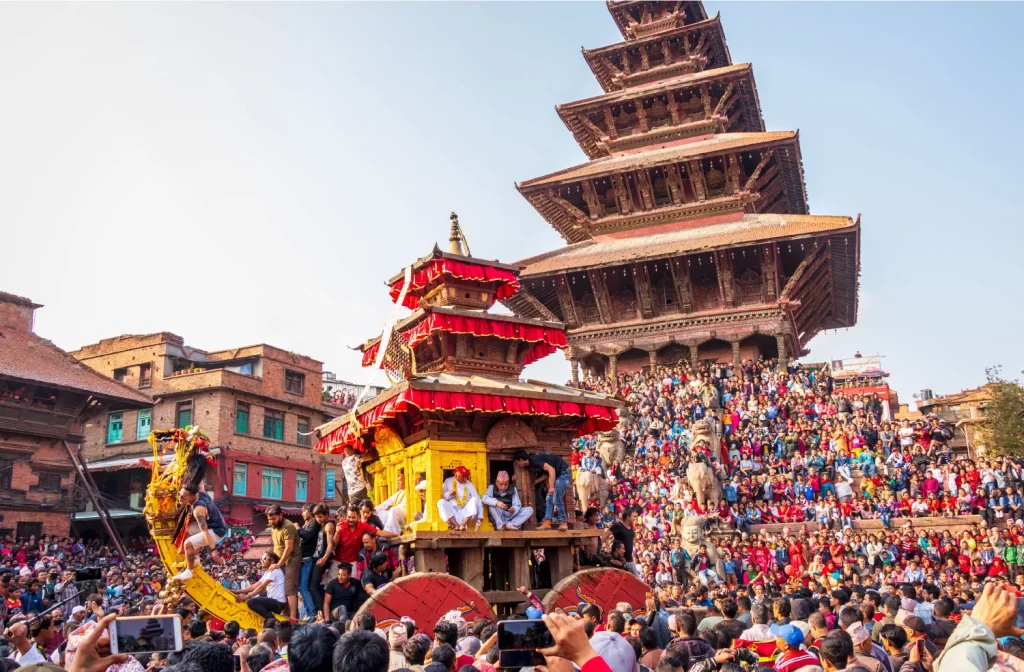
The Celebrations:
- Rath Yatra (Chariot Procession): A highlight of Bisket Jatra is the grand chariot procession that takes place over several days. Two massive wooden chariots, one carrying the god Bhairab and the other the goddess Bhadrakali, are pulled through the narrow streets of Bhaktapur. This is a grand spectacle, with local men and women participating enthusiastically.
- Yosin (Lingam) Raising: One of the most iconic events of the festival is the Yosin or Lingam raising. A massive wooden pole with flags is erected at the heart of Bhaktapur’s Durbar Square. The ceremony requires precision and teamwork, and it often turns into a friendly competition among different groups in the town.
- Tug-of-War: A unique tradition of Bisket Jatra is the tug-of-war between different groups representing various sections of the town. The rope is stretched across a river, and the competition symbolizes a cosmic tug-of-war between the gods and demons.
- Dancing and Singing: The festival features various traditional dances and singing performances. Local bands and musicians play traditional instruments, creating a festive atmosphere.
- Traditional Attire: Participants and observers often dress in traditional attire. Brightly colored clothes, masks, and elaborate headdresses are common during the celebrations.
- Community Gatherings: Bisket Jatra is a time for families and friends to come together, share meals, and exchange greetings. It strengthens the sense of community and togetherness.
- Religious Rituals: Alongside the exuberant festivities, religious rituals are performed. People visit temples and make offerings to seek blessings for the New Year. The gods Bhairab and Bhadrakali are also worshipped.
11. Rato Machindranath Jatra: Pulling the Chariot
Rato Machindranath Jatra is a grand procession of a towering chariot, with locals pulling it through the narrow streets of Patan. It is believed to bring rainfall and a good harvest.
This festivals in Nepal is a significant deity in the Newar community of the Kathmandu Valley. The festival celebrates the god of rain and compassion and is believed to bring rain and prosperity to the region. The chariot procession is a visual representation of the deity’s journey and is regarded as a time for seeking blessings and well-being.
The Celebrations:
- Chariot Construction: The festival begins with the construction of a towering chariot made of wood and bamboo. The chariot, which can reach impressive heights, is a masterpiece of craftsmanship.
- Rituals and Blessings: Throughout the festival, religious rituals and ceremonies are held at temples dedicated to Rato Machindranath. Devotees offer prayers and seek blessings for a bountiful harvest and good fortune.
- Chariot Procession: The heart of the festival is the grand chariot procession. Devotees and locals come together to pull the colossal chariot, and the entire event is a magnificent spectacle. The chariot is painstakingly moved through narrow streets with the strength and coordination of the participants.
- Tug-of-War Tradition: One of the most unique features of the festival is the annual tug-of-war competition. Groups representing different neighborhoods or communities engage in a friendly but spirited contest to determine the direction in which the chariot should be pulled.
- Traditional Attire: Participants often don traditional clothing, including colorful dresses and masks. The attire is a blend of cultural identity and a mark of respect for the occasion.
- Music and Dance: The festival features traditional music, dance performances, and cultural displays. It’s a time for artists and musicians to showcase their talents and entertain the crowds.
- Community Gatherings: Families and friends come together to celebrate, share meals, and exchange greetings. The festival fosters a sense of unity and solidarity within the community.
- Cultural Exhibitions: The festival often includes exhibitions and displays of traditional art and crafts, providing a platform for local artisans to showcase their talents.
12. Yomari Punhi (योमरी पुन्ही): The Festival of Dumplings
Yomari Punhi is a Newari festival celebrated with great enthusiasm. People make and share Yomari, a delicious dumpling filled with molasses and sesame seeds.
This Festivals in Nepal marks the end of the rice harvest season and is celebrated on the full moon day of December. The festival not only commemorates the season’s bounty but also carries deep religious and cultural significance.
The festival emphasizes the significance of traditional practices, communal harmony, and the preservation of culinary heritage. Yomari Punhi not only brings people together but also offers a window into the rich cultural tapestry of Nepal, highlighting the enduring traditions and culinary delights of the Newar community.
13. Seto Machhendranath Jatra: The Rain God’s Procession
Seto Machhendranath Jatra is a month-long chariot procession dedicated to the rain god. It is celebrated with much fanfare, and locals believe it ensures a good harvest. Seto Machhendranath, also known as Janabaha Dyo, is a deity deeply venerated by both Hindus and Buddhists in Nepal. The festival is celebrated to seek blessings for rain, good harvest, and prosperity. It is also believed to promote harmony and unity among the diverse religious communities in Nepal.
This festivals in Nepal also celebrate same as Rato Machhendranath Jatra by Newari Community.
Seto Machhendranath Jatra is more than just a religious festival; it is a celebration of community, culture, and the enduring traditions of Kathmandu. It brings together people of diverse backgrounds to participate in the awe-inspiring act of pulling a colossal chariot through ancient streets.
14. Ghode Jatra: Horse Racing in Kathmandu
Ghode Jatra is one of the top 20 festivals in Nepal featuring horse racing and acrobatics in Kathmandu. It’s an exciting spectacle that brings the city’s residents and tourists together.
This Festivals holds both historical and cultural significance. Historically, it is said to have originated during the rule of King Pratap Malla, who sought to establish his authority over neighboring cities. The festival symbolizes the victory of King Pratap Malla’s cavalry.
The Celebrations:
- Equestrian Parade: The heart of Ghode Jatra is the impressive equestrian parade held at Tundikhel, an open ground in the heart of Kathmandu. The Nepalese army showcases their horsemanship skills, and various mounted police units participate in the parade.
- Obstacle Race: A thrilling obstacle race on horseback is a central part of the festival. Riders, dressed in traditional attire, compete to navigate their horses through a challenging course of hurdles and obstacles. This event draws both participants and enthusiastic spectators.
- Cultural Dances: Ghode Jatra is not only about horses but also includes traditional dances, cultural performances, and music. Local artists perform dances that celebrate the vibrant culture of Nepal.
- Community Gatherings: The festival is a time for families and friends to come together, share meals, and exchange greetings. It strengthens the sense of community and togetherness.
- Public Participation: Ghode Jatra is not limited to professional equestrians. It encourages public participation, and many local riders showcase their horsemanship skills in the parade and race.
- Traditional Attire: Participants often wear traditional Nepali clothing and colorful masks. It’s a way to express respect for the occasion and showcase the richness of Nepali culture.
- Military Showcase: The festival often includes demonstrations by the Nepalese military and police units, showcasing their equestrian abilities and training.
15. Shree Panchami: Celebrating Education
Shree Panchami is a day dedicated to Saraswati, the goddess of knowledge. Students across Nepal celebrate by visiting temples and honoring their books and instruments.
This Festivals in Nepal is celebrated on the fifth day of the bright half of the lunar month of Magh (usually falling in late January or early February). It holds deep spiritual and cultural importance, as it is believed to be the day when Saraswati, the embodiment of wisdom and learning, was born.
16. Sonam Lhosar: The Tamang New Year
Sonam Lhosar is the New Year celebrated by the Tamang community. It’s marked by cultural dances, music, and traditional Tamang attire. This is celebrated on the first day of the Tamang calendar, which usually falls in January or February. The festival is not only about welcoming the New Year but also about preserving and promoting Tamang culture and heritage.
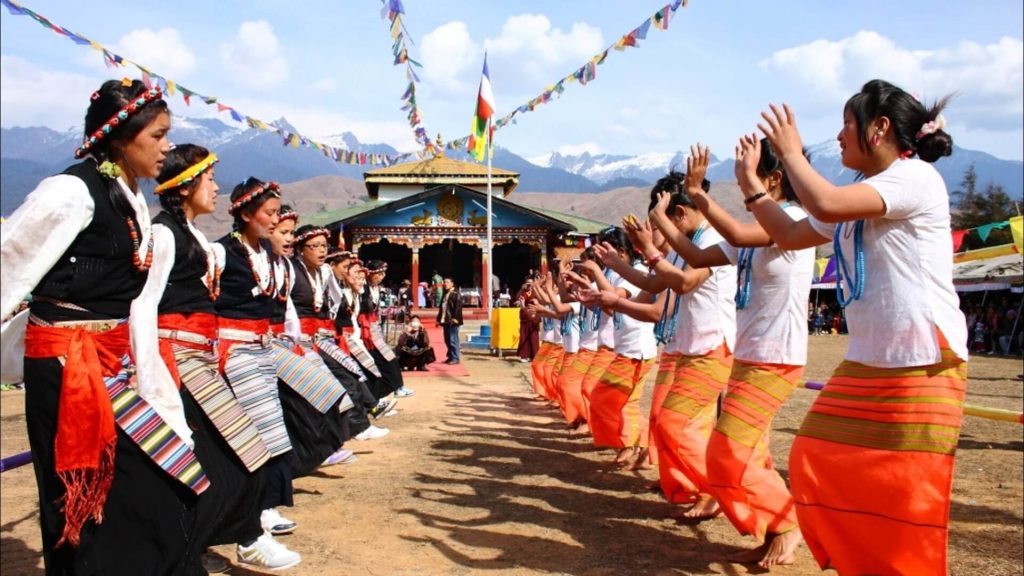
Sonam Losar is not just a New Year celebration; it is a reflection of the rich cultural heritage of the Tamang community. The festival emphasizes the importance of preserving cultural traditions and promoting unity among community members.
17. Tamu Lhosar: The Gurung New Year
Tamu Lhosar celebrates the New Year for the Gurung community, also one of the top 20 festivals in Nepal. It’s a day filled with cultural performances, traditional food, and rituals. Typically falls in December or January and marks the first day of the Gurung calendar. It’s a time for the Gurung community to reflect on the past year, express gratitude for the harvest, and look forward to the year ahead.
Tamu Losar is not just a New Year celebration; it is a reflection of the rich cultural heritage of the Gurung community. The festival emphasizes the importance of preserving cultural traditions and promotes unity among community members.
18. Haritalika Teej: A Women’s Festival
**Haritalika Teej**, a festival dedicated to the well-being of husbands and family life, is primarily celebrated by women. They fast and pray for their husbands’ long lives and for marital bliss. The festival is celebrated with great devotion and enthusiasm.
Teej is one of the top 20 festivals in Nepal that celebrates the strength, love, and devotion of women in the context of their family life. It underscores the importance of maintaining a harmonious and loving relationship between husbands and wives. The swinging, singing, and dancing symbolize the joy of togetherness and the hope for an enduring bond.
The Celebrations:
- Fasting and Abstaining: The most significant aspect of Teej is fasting. Women observe a day-long fast during which they abstain from food and water. Some women, particularly married ones, abstain from both food and water.
- Worship of Goddess Parvati: Women visit temples dedicated to Goddess Parvati, and homes are adorned with images or idols of the goddess. Devotees offer flowers, fruits, and other offerings as a mark of devotion.
- Dressing in Red: On Teej, women traditionally wear red attire and adorn themselves with beautiful jewelry. Red is considered an auspicious and sacred color, symbolizing the love and devotion they have for their husbands.
- Dance: Women, especially unmarried girls, gather in groups and enjoy singing and dancing, often on swings. The swinging symbolizes the joy and delight of marital life and the hopes of finding a suitable partner.
- Mehendi (Henna) Application: Decorating hands and feet with intricate mehendi designs is an integral part of the celebrations. Women apply mehendi as a sign of beauty, love, and well-being.
- Feasting: After the day-long fast, women break their fast with a special meal, which usually includes sweets and other traditional dishes. It’s also a time for families to come together and share meals.
- Gift Exchange: Husbands and family members often give gifts to the women as a gesture of appreciation and love. It’s a way of acknowledging their devotion and the sacrifices made during the fast.
19. Chhath Puja: Honouring the Sun God
Chhath Puja, often referred to as Chaath Prava, is a revered and ancient Hindu festival predominantly celebrated in the Indian states of Bihar, Jharkhand, and eastern Uttar Pradesh, as well as in some regions of Nepal. This festival is dedicated to the worship of the sun god, Surya, and Chhathi Maiya, his sister, for their blessings of life, energy, and well-being.
It is observed on the sixth day of the lunar month of Kartik, typically in October or November, and it extends for four days. The festival carries deep spiritual and cultural significance, as it celebrates the sun, which is considered the source of life and energy. It is also a way to express gratitude to the sun god for sustaining life on Earth.
Chhath Puja is also one of the top 20 festivals in Nepal that celebrates the sun as a life-giver and a symbol of purity and energy. It underscores the importance of environmental conservation, cleanliness, and purity, as the rituals involve maintaining strict discipline and performing acts of gratitude to nature.
20. Sita Bibaha Panchami: The Wedding of Sita
Sita Bibaha Panchami commemorates the wedding of Lord Ram and Sita, a significant event in Hindu mythology. This one of the top 20 festivals in Nepal is celebrated with grand processions and reenactments of the legendary wedding ceremony. Sita Bibaha Panchami is celebrated on the fifth day of the bright half of the lunar month of Magh, which usually falls in January or February. It marks the divine union of Sita, an incarnation of the goddess Lakshmi, with Lord Rama, an incarnation of Lord Vishnu. The wedding is described in the epic Ramayana and symbolizes love, commitment, and virtue.
Sita Bibaha is a festival that celebrates the virtues of love, commitment, and the divine union of two souls. It underscores the importance of virtue and devotion, as represented by Goddess Sita and Lord Rama in Hindu mythology.
These are just a glimpse of the many top 20 festivals in Nepal that color Nepali’s cultural tapestry. The richness and diversity of these celebrations make Nepal a unique and exciting destination for cultural enthusiasts.
Conclusion
Nepal, with its stunning landscapes and diverse culture, is a land of festivities and celebrations. These top 20 festivals in Nepal not only showcase the religious and cultural diversity but also bring people together, reinforcing the bond among communities.
3 Terrible lies: People tell at Job Interviews
Now that we’ve explored these vibrant festivals, it’s time to address some common questions that may arise:
Frequently Asked Questions
1. Which is the most significant festival in Nepal?
The most significant festival in Nepal is Dashain, often referred to as Vijaya Dashami. It’s the longest and most widely celebrated festival in the country, uniting people from various backgrounds.
2. Are these festivals open to tourists?
Absolutely! Many of these festivals, such as Tihar, Holi, and Buddha Jayanti, are open to tourists and provide an excellent opportunity to immerse yourself in Nepal’s culture and traditions.
3. When is the best time to visit Nepal for these festivals?
The best time to experience these festivals is during the autumn months, from September to November, when the weather is pleasant, and most of the major festivals occur.
4. What should I wear when attending these festivals?
While there is no strict dress code, it’s advisable to dress modestly and respectfully. In some religious sites, you may be required to cover your head and remove your shoes.
5. Can tourists participate in the rituals of these festivals?
Tourists are usually welcome to observe and participate in some parts of the festivities, but it’s essential to be respectful and follow local customs and guidelines.
Top 20 Festivals in Nepal are a window into the heart of this remarkable nation. From the grandeur of Dashain to the exuberance of Holi, these celebrations offer an unforgettable glimpse into the country’s culture and heritage. So, the next time you plan your travels, consider timing it with one of Nepal’s fantastic festivals, and you’ll experience the vibrant soul of this beautiful Himalayan nation.
Remember, these festivals are not just events; they are experiences that will leave an indelible mark on your heart and mind.
Recent Articles:
- Top 10 Registered IVF Clinics in Nepal (2025)
- Top-Rated IT Training Institute in Kathmandu, Nepal You Can Trust!
- Visit Top 10 Job portal in Nepal : Find Jobs In Nepal
- Top 22 Valentine’s Day Gifts for Him & Her (Trending 2025)
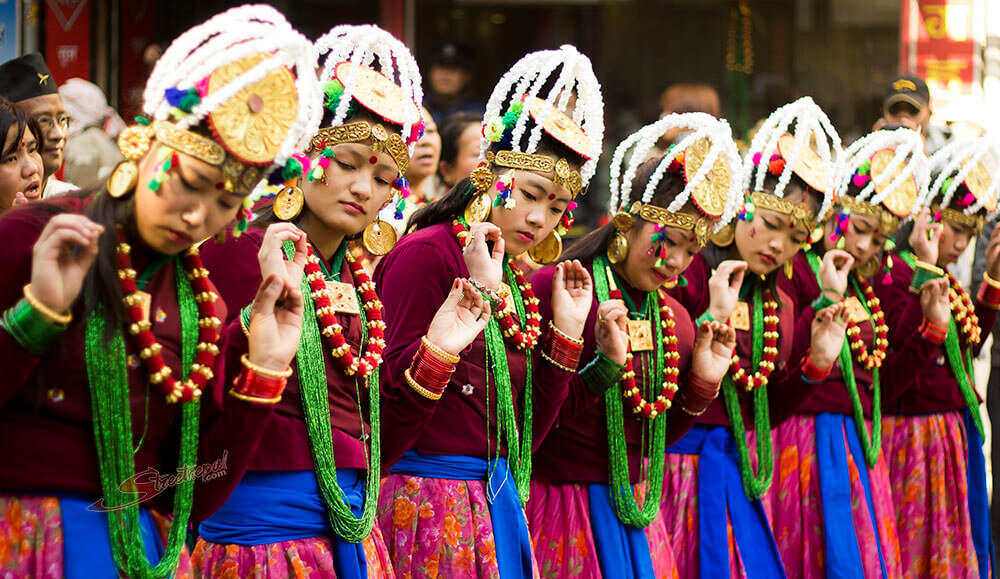
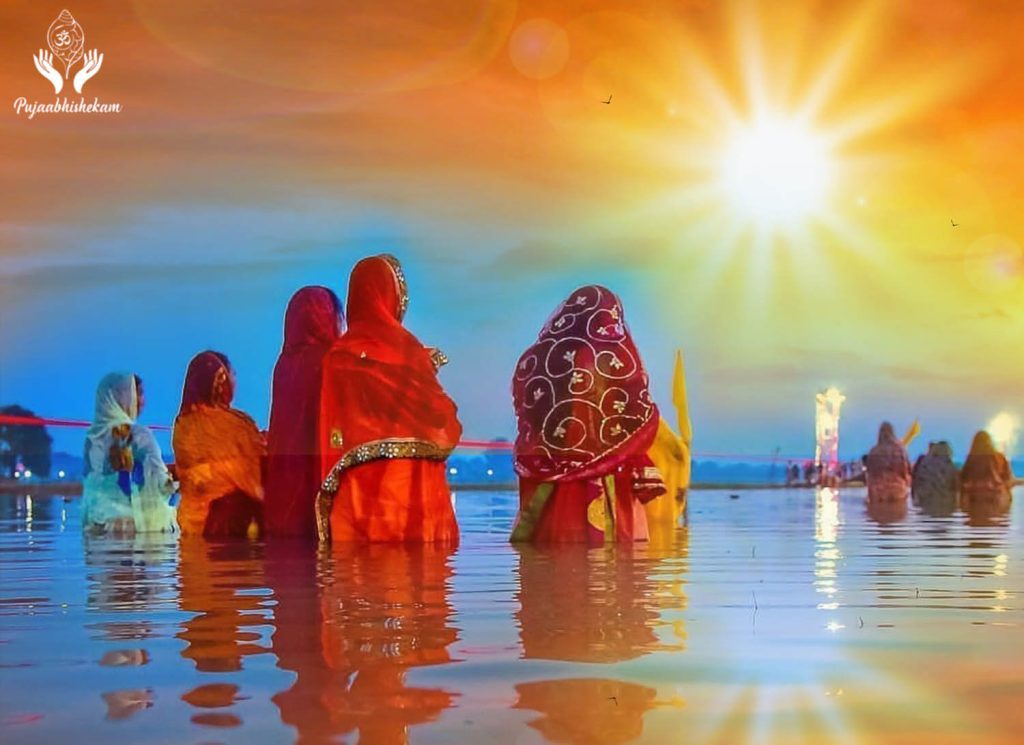



![[2025 Updated] Top 10 Digital Marketing Agencies in Nepal Ranked!](https://mysticrubs.com/wp-content/uploads/2022/05/top-10-digital-marketing-company-in-nepal.png)








